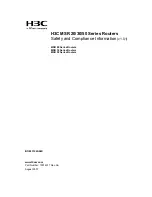
To update operational code when the 2212 is operating in recovery
mode:
To update the operational code on hard file or compact flash, from the
SVC>
prompt, type TFTP to get an operational load image from a server
to the IBM 2212. See “TFTP File Transfer using the Operating Software”
on page A-22 for instructions on using TFTP from
SVC>
.
To update the operational code on system card flash:
1. Access the
SVC>
prompt as described on page “Accessing the
Service Recovery Prompt (SVC>)” on page A-5.
2. Type the writeos command to write the a new version of operational
code to the system card flash from the specified software load bank.
The system prompts you for the bank from which to write the
operational code.
3. Type reboot.
Using the Configuration Program’s Communications Feature to
Manage Configuration Files
Question How do I use the Configuration Program's communications feature and
Send option to manage configuration files?
Answer
For optimal configuration management, it is recommended that you use
the Configuration Program and its configuration database to manage all
your IBM 2212 configuration files.
The design of change management facilitates good control of the
configuration files. Keeping the ACTIVE file and the file that is stored in
the configuration database the same assures that a copy of the ACTIVE
file is always available.
When you use the Send option of the Configuration Program’s
communications feature to send a new configuration to the IBM 2212,
the new configuration is written to the ACTIVE bank and overwrites the
file located in the position just below the currently ACTIVE configuration.
The new configuration is PENDING if a time is set for a reset. If the
configuration file is sent without a specified time for the reset to occur, it
gets AVAIL status.
For example, suppose that CONFIG 2 is ACTIVE. The new configuration
file is written to CONFIG 3. It has a status of PENDING if a reset time is
associated with it; if not, it has a status of AVAIL.
If the file has a status of PENDING, CONFIG 2 becomes AVAIL and
CONFIG 3 becomes ACTIVE when a reset occurs. The next file that is
sent from the Configuration Program will be placed in CONFIG 4. If a
reset time is associated with the file, it will have the PENDING status
and will become ACTIVE when the next reset occurs. If another file is
then sent, it is placed in CONFIG 1 because the currently ACTIVE file is
now in CONFIG 4. This arrangement results in a circular queue.
If the downloaded file has a status of AVAIL, a reset does not change its
status. If another file is sent down, it overwrites that file because the
ACTIVE file has not changed and the newly downloaded file always
occupies the location just behind the ACTIVE file.
Appendix A. Common Tasks
A-25
Summary of Contents for IBM 2212-40H
Page 1: ...2212 Access Utility ÉÂÔ Installation and Initial Configuration Guide GA27 4216 01 ...
Page 2: ......
Page 3: ...2212 Access Utility ÉÂÔ Installation and Initial Configuration Guide GA27 4216 01 ...
Page 6: ...Trademarks B 7 Safety Notices B 8 Index X 1 iv 2212 Install and Initial Config ...
Page 10: ...viii 2212 Install and Initial Config ...
Page 16: ...1 6 2212 Install and Initial Config ...
Page 20: ...Figure 2 1 System Card LEDs 2 4 2212 Install and Initial Config ...
Page 26: ...2 10 2212 Install and Initial Config ...
Page 34: ...3 8 2212 Install and Initial Config ...
Page 38: ...4 4 2212 Install and Initial Config ...
Page 68: ...A 30 2212 Install and Initial Config ...
Page 81: ...Appendix B Notices B 13 ...
Page 82: ...B 14 2212 Install and Initial Config ...
Page 85: ......
Page 89: ......
















































